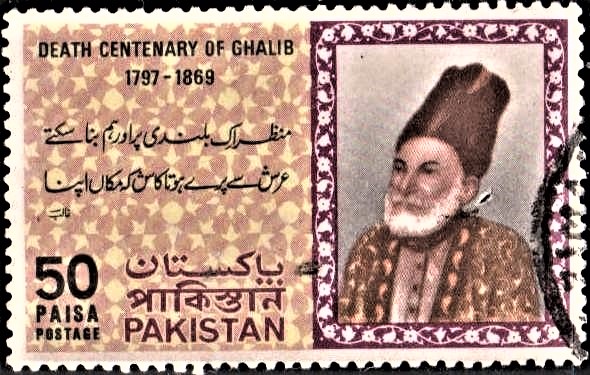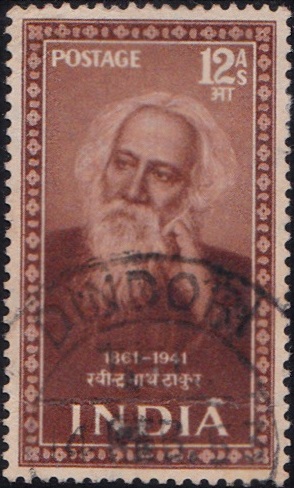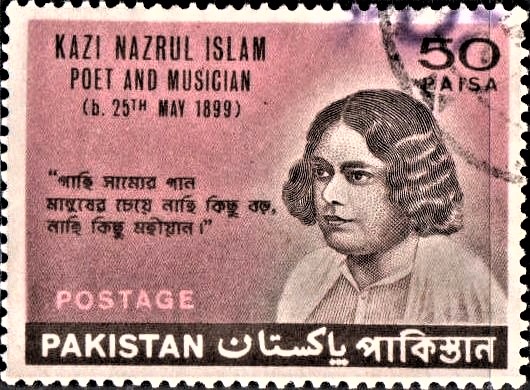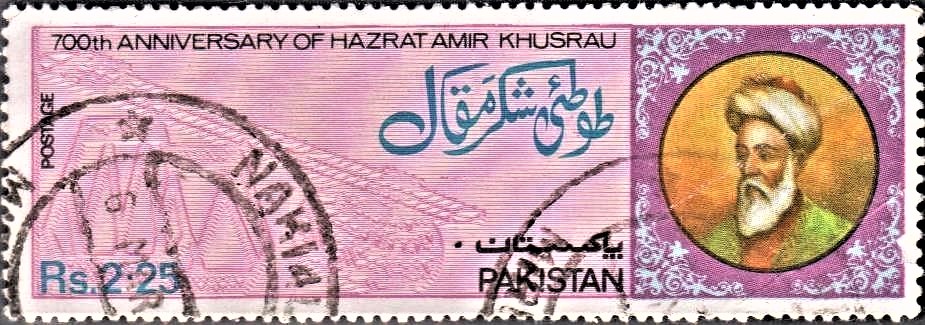
India on Mirza Ghalib 1969
A commemorative postage stamp on the Death Centenary of ‘Dabir-ul-Mulk‘ Mirza Galib (Asad), an Urdu and Persian poet during Last Mughal emperor Bahadur Shah Zafar II :
 Issued by India
Issued by India
Issued on Feb 17, 1969
Issued for : This great son of Delhi and of India breathed his last a hundred years ago. His contributions to Urdu literature are unique and unsurpassed. He was largely responsible for the evolution of Urdu, essentially a language of the masses, into an effective medium suitable for modern prose and poetry. India is observing in a fitting manner the centenary of his passing. The Indian P & T Department is proud to pay its homage to this distinguished poet and man of letters by issuing a commemorative postage stamp in his honour.
Description of Design : The design of the Stamp is horizontal and depicts a portrait of Ghalib on the left side of the stamp. In the background script of his letter is shown and a seal appears at the right in middle portion of stamp.
Type : Stamp, Postal Used
Colour : Mineral Red & Raw Sienna
Denomination : 20 Paise
Overall Size : 4.06 X 2.28 cms.
Printing Size : 3.80 X 2.00 cms.
Perforation : 14 x 14½
Watermark : Printed on unwatermarked paper
Number Printed : 30,00,000
Number per issue Sheet : 50
Printing Process : Photogravure
Designed and Printed at : India Security Press
Name : Mirza Asadullah Baig Khan
Born on Dec 27, 1797 at Agra, Uttar Pradesh, India
Died on Feb 15, 1869 at Delhi, India
About :
- Asad Ullah Beg Khan, famous in later life as Mirza Ghalib was born at Agra on 27th December, 1797. His father who was a wealthy nobleman died when Ghalib was only five years old. He was then brought up by an uncle who too died while the boy was hardly nine. A small pension in lieu of the family Jagir was sanctioned for the maintenance of Ghalib and his younger brother.
- According to the custom of the times, Ghalib was married at a young age. His father-in-law, Mirza Ilahi Baksh, was a poet of distinction at Delhi. Ghalib‘s marriage thus introduced him to the exclusive literary circles of the age. His marriage also resulted in Ghalib moving from Agra and making Delhi his permanent home.
- Ghalib lived a life of luxury at Delhi, but spent most of his leisure in reading of writing Persian and Urdu verse. An important development was his journey to and return from Calcutta between the years 1826 and 1829. Ghalib undertook the trip for securing a larger share of his patrimony but his efforts ended in failure. However, there were compensations. He visited Lucknow, Varanasi and other places during the course of his journey and got acquainted with literary trends at these places and at Calcutta. This was a valuable experience and helped in enlarging his poetic horizon, and he returned to Delhi a wiser if a sadder man. The next few years witnessed considerable literary activity on the part of Ghalib. His collection of Urdu poems, ‘Diwan-E-Ghalib‘, was published in 1841. Another important publication was ‘Panj Ahang‘, a voluminous work in Persian which appeared in 1849.
- The next important phase of his life coincided with the First War of Independence in 1857 and its aftermath. Earlier, he had come close to Bahadur Shah Zafar, the last Moghul Emperor and had been appointed as the court historian. This made him suspect in the eyes of the Britain when they returned to Delhi after the upheaval. Ghalib gives a vivid account of conditions at Delhi at the time in his Persian work, ‘Dastan bu‘. The sufferings of the people of Delhi knew no bounds when the British re-established themselves at the old imperial capital and Ghalib had his share of the misfortunes.
- The last years of his life were marred by poverty and bad health. He was supported during this period by generous help from the Rampur Court. But used as Ghalib was to lavish living, he was always in debt. His humour, however, never forsook him and he continued to write to his many friends from his sick bed. The only important literary event during this period was the publication of a collection of his Urdu letters in 1868. The poet died on February 15,1863 after a long and painful illness.
- Although Ghalib wrote more in Persian than in Urdu, it is on account of his Urdu poems that he is chiefly remembered. He had started writing verse while still young but his early style was stilted and circumscribed by convention. In fact, Urdu poetry till then was largely characterised by the deliberate employment of difficult and highly involved expressions and a debased form of erotic sentiment. Although Ghalib too wrote about love, his “ghazals” encompass all aspects of life and give expression to some of the profoundest thoughts and feelings of man. When it is remembered that Ghalib‘s main claim to greatness rests on a single volume of Urdu poems of only about a hundred pages, the excellence of their quality may be easily imagined. He was one of the greatest poets in Urdu and what is even more significant, very few other Urdu poets have so far succeeded in presenting as complete a picture of human life as Ghalib did.
- Ghalib‘s contribution to the development of Urdu prose is equally noteworthy. His letters marked a new style of writing in Urdu, a direct and conversational form which set the pace for Urdu prose writers in later years. His letters make very good reading and vibrato with humour, richness of interesting detail and an intimate touch.








[…] Issued for : To commemorate the works of renowned painters of Pakistan, Pakistan Post Office has decided to bring out a series of postage stamps on the ‘PAINTERS OF PAKISTAN’. The first stamp in the “PAINTERS OF PAKISTAN” series which is being issued on April 19, 1990 of Re. 1/- denomination depicts the famous calligraphic work of (late) Shakir Ali containing the following urdu verse of the illustrious poet Mirza Asadullah Khan ‘Ghalib’. […]
[…] Kulliyar–e–Mir Taqi Mir, Jurrat, Diwan–i–Soz and indeed the manuscript of Diwan-e-Ghalib with corrections in the poet’s own handwriting. There are also two rare copies of the first […]
[…] varied achievements and personal magnetism, he won several admirers in all classes of society. Mirza Ghalib was one of his greatest […]